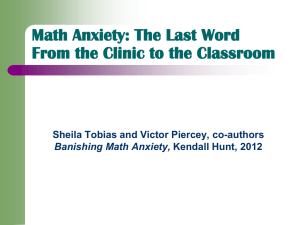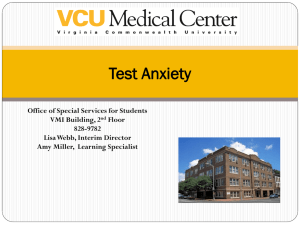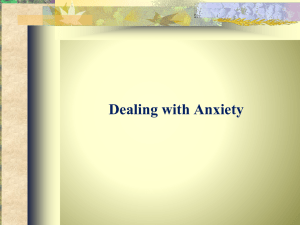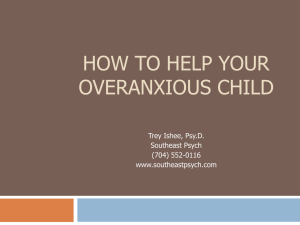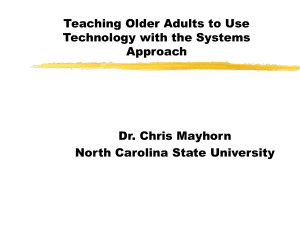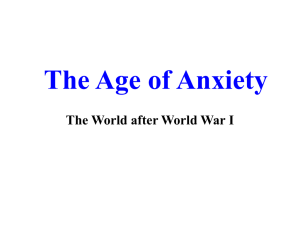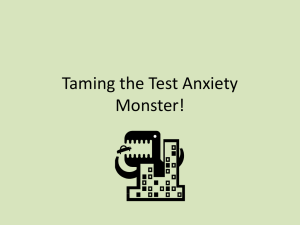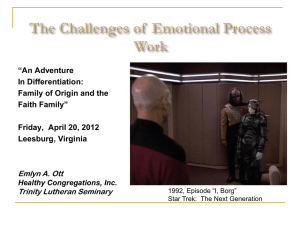Welcome to UT *.
advertisement
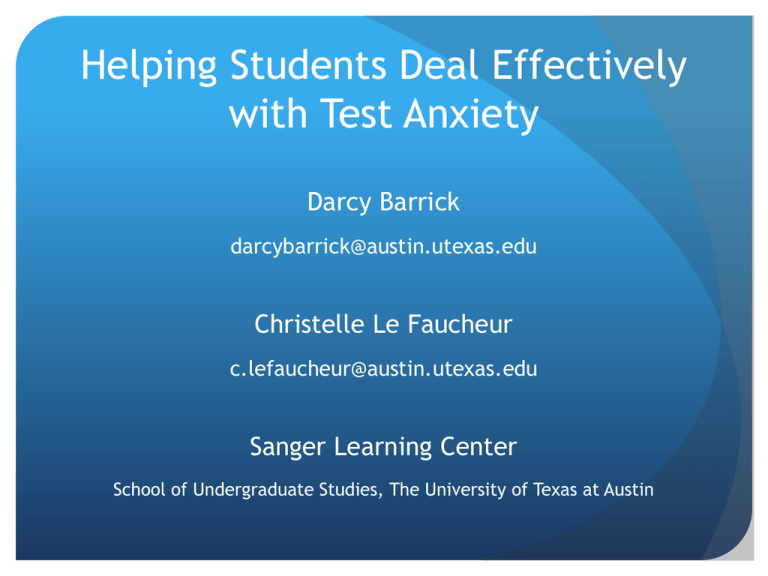
Helping Students Deal Effectively with Test Anxiety Darcy Barrick darcybarrick@austin.utexas.edu Christelle Le Faucheur c.lefaucheur@austin.utexas.edu Sanger Learning Center School of Undergraduate Studies, The University of Texas at Austin Objectives For professionals to be able to Speak to the history of & trends in test anxiety research Identify four parts of the suggested integrated approach to test anxiety Suggest effective self-calming strategies to students experiencing test anxiety Identify times when it would be important to refer test anxiety students to counseling/mental health services What is Anxiety? Physiological / psychological response to a perceived threat. Physiological signs Psychological signs Upset stomach Confusion Restlessness Memory blanking Sleep problems Irritability Muscle tension Impaired concentration Headache Poor judgment Back problems Frustration What is Test Anxiety? Test anxiety is defined as perceived arousal, reported worry, self-denigrating thoughts, tension, and reports of somatic symptoms in exams or similar evaluative situations. Estimated to impact as many as 20-35% of students (Zeidner, 1998) Seems to be on the increase as more emphasis is placed on test in the public school system and as tests increasingly determine admission to specific programs/schools. (Kadison & DiGeronimo,2004) What Test Anxiety Is Not A diagnostic category on its own (although it can be one manifestation of other diagnoses such as anxiety disorders, depression, attention disorders, or learning disorders that may legally entitle a student to classroom accommodations) An experience caused solely by insufficient preparation (although preparation techniques are a key element in positively impacting the anxiety experience) Research Comes from a number of fields including education, counseling, behavioral science, and various branches of psychology Overlaps with research areas such as Self-efficacy Learned helplessness Self regulation Motivation Perfectionism Personality traits Origins of Test Anxiety Biological Constitution Socialization and Early Childhood Experiences Test Anxiety Educational Environment Unique Learning Experiences Configuration of factors in test anxiety development, in Zeidner, 1998 Test Anxiety Research: Milestones Drive-oriented and physiological stress/arousal perspectives( Mandler and S. Sarason's 1952) Liebert and Morris (1967) – constructs of emotionality (physiological arousal) and worry (concern about performance) More Milestones Cognitive-attentional (interference) model (Wine (1971) worry, cognitive interference, and self-denigration Skills deficits (Culler & Halahan 1980; Kirkland and Hollandsworth, 1980) Self-regulation (Carver & Scheier, 1991) Self-worth (Covington, 1992) Spielberger’s Transactional model and State-Trait Model (Spielberger & Vagg,1995) Anxiety as a personality trait (A-Trait) and as a personality state (A-State) What It Impacts Affect Worry, depression, hopelessness Physical symptoms Tension, elevated heart rate, nausea, sweating Behavior Procrastination, avoidance, ineffective study and escapism Cognition Self-preoccupied thinking Impaired information processing Input (Encoding and Acquisition) Storage and Processing Retrieval and Output Test Anxiety and Information Processing Input Encoding and Acquisition Storage and Processing Retrieval and Output TEST ANXIETY IMPACT OF TEST ANXIETY AT DIFFERENT STAGES OF INFORMATION PROCESSING, ZEIDNER 1998 Academic Outcomes 60 years of research have demonstrated a clear negative association between test anxiety and academic performance. Students don’t perform to their potential and scores misrepresents their level of knowledge and understanding Academic persistence and achievement can be negatively impacted. Test anxiety is a complex, multidimensional construct Heterogeneous nature of test anxiety Develops from multiple pathways Yields different types of test-anxious students Demands an integrated approach to treatment Damer and Melendres, 2011 Intervention Meta-analysis of 56 empirical test anxiety intervention studies (Ergene, 2003) Most effective are combination of Skill-focused strategies (study skills training, test-taking skills training) with Cognitive approach (rational emotive therapy, cognitive restructuring) and/or Behavioral approach (systematic desensitization, relaxation training, biofeedback, anxiety inductions) Helping Students Deal Effectively with Test Anxiety: An Integrated Approach History > Reframing > Self-Calming > Study Effectiveness Additional referral options at UT Austin Counseling and Mental Health Center Private counseling appointments Short-term test anxiety group Stress management class (Optimizing Your Potential) Mindfulness meditation group On-line resources -www.cmhc.utexas.edu/resources.html Mind/Body Lab – guided relaxation recordings, massage chairs, biofeedback Student History Duration – origin (elementary, secondary, college, etc.) Intensity -- from 1-10 Any complete blanking, how long does it last* Intense physical symptoms* such as fainting or vomiting? Stress level on non-test days* Impact Experience of life – tired, stressed, etc. Outcomes – grades > ability to study > motivation for school Other Anxiety in other areas of life* -- social, family, relationship, finances, etc. Past diagnoses relevant to anxiety* . Reframing 1. What a test is A thinking task 2. Primary job during a test To think … as clearly as possibly based on what I currently know Choosing a job within your control Get it all right / Not make any mistakes Do better than other people Prove something to the professor Get into pharmacy school Make my parents happy Make my family proud Get an A 3. Secondary job – to self-calm Some anxiety improves performance If stress progresses to point that you can’t think, your responsibility shifts to your secondary job, to self-calm. Positively impacting the anxiety experience is always a combination of learning selfcalming techniques AND improving the effectiveness of study techniques. Self-Calming Techniques -- see packet Body Emotions Thoughts Study Effectiveness Techniques -- see packet Plan weekly Preview (for content and organization) Take in new information: Read<>Take lecture notes Review notes (to find and fill gaps) Self-quiz Take Test(s) Analyze results Final Resources Bibliography Instruments for Assessing Test Anxiety ------------As a result of this session, I will ________________________________________________________________ ________________________________________________________________ ________________________________________________________________


